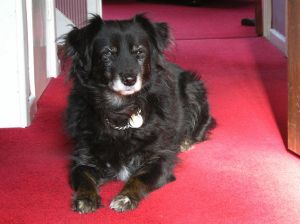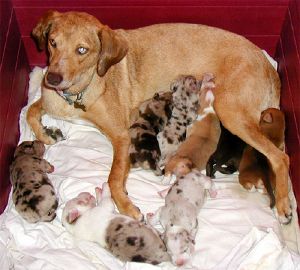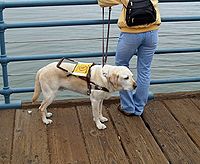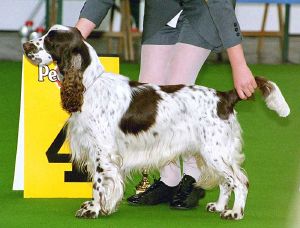Difference between revisions of "Dog" - New World Encyclopedia
| Line 77: | Line 77: | ||
==Terminology== | ==Terminology== | ||
| − | The [[English language|English]] word ''dog'', in common usage, refers to the domestic [[pet]] dog, ''Canis lupus familiaris''. The species was originally classified as ''Canis familiaris'' by Linnaeus in 1758. In 1993, dogs were reclassified as a subspecies of the gray wolf, ''Canis lupus'', by the [[Smithsonian Institution]] and the American Society of Mammalogists | + | The [[English language|English]] word ''dog'', in common usage, refers to the domestic [[pet]] dog, ''Canis lupus familiaris''. The species was originally classified as ''Canis familiaris'' by Linnaeus in 1758. In 1993, dogs were reclassified as a subspecies of the gray wolf, ''Canis lupus'', by the [[Smithsonian Institution]] and the American Society of Mammalogists. |
The English word ''dog'' might derive from the Old English "''docga''", a "powerful breed of canine" like the modern Mastiff. The French ''dogue'' and Spanish ''dogo'' as in ''dogo Argentino'' are borrowings from English. The English word ''hound'' is a cognate of German ''Hund'', Dutch ''hond'', common Scandinavian ''hund'', Icelandic ''hundur'' which, though referring to a specific breed in English, means "dog" in general in the other Germanic languages. ''Hound'' itself derives from the [[Proto-Indo-European language|Proto-Indo-European]] *kwon-, which is the direct root of the Greek κυων (kuōn) and the indirect root of the Latin [[canis]] through the variant form *kani-. | The English word ''dog'' might derive from the Old English "''docga''", a "powerful breed of canine" like the modern Mastiff. The French ''dogue'' and Spanish ''dogo'' as in ''dogo Argentino'' are borrowings from English. The English word ''hound'' is a cognate of German ''Hund'', Dutch ''hond'', common Scandinavian ''hund'', Icelandic ''hundur'' which, though referring to a specific breed in English, means "dog" in general in the other Germanic languages. ''Hound'' itself derives from the [[Proto-Indo-European language|Proto-Indo-European]] *kwon-, which is the direct root of the Greek κυων (kuōn) and the indirect root of the Latin [[canis]] through the variant form *kani-. | ||
| Line 83: | Line 83: | ||
In breeding circles, a male canine is referred to as a ''dog'', while a female canine is called a ''bitch''. The father of a litter is called the ''sire'', and the mother of a litter is called the ''dam''. Offspring are generally called ''pups'' or ''puppies'' until they are about a year old. A group of offspring is a ''litter''. The process of birth is ''whelping''. Many terms are used for dogs that are not purebred. | In breeding circles, a male canine is referred to as a ''dog'', while a female canine is called a ''bitch''. The father of a litter is called the ''sire'', and the mother of a litter is called the ''dam''. Offspring are generally called ''pups'' or ''puppies'' until they are about a year old. A group of offspring is a ''litter''. The process of birth is ''whelping''. Many terms are used for dogs that are not purebred. | ||
| − | The constellations | + | The constellations Canes Venatici, Canis Major and Canis Minor are named from the [[Latin language|Latin]] word for "dog," for their perceived resemblance to dogs. |
| + | |||
| + | ==Breeds== | ||
| + | |||
| + | Different breeds of dogs emerged over time due to environmental factors and human selection. In ancient [[Egypt]] dogs looking like the modern Greyhound and the Mastiff are pictured in art. In ancient [[Roman]] writings miniature pet dogs like modern toy breeds are mentioned (Clutton-Brook 1999). | ||
| + | |||
| + | As of 2006, the American Kennel Club recognized 153 breeds, divided into 7 groups (AKC 2006): | ||
| + | |||
| + | * '''Sporting breeds''' were originally breed and trained to assit gun-wielding hunters in finding recovering birds and other small game. They include pointers, spainiels, and retrievers. | ||
| + | |||
| + | * '''Hounds''' were breed to track and engage larger hunted animals. They include the Bloodhound, the English Foxhound, and the Beagle. | ||
| + | |||
| + | * '''Working breeds''' were breed for various tasks; such as guarding people, livestock, and property; pulling sleds, and rescuing people from water or snow. They include the Rotweiler, the Saint Bernard, and the Akita. | ||
| + | |||
| + | * '''Terriers''' were originally breed to catch and kill small animals, especially [[rat]]s, without the help of a human hunter. | ||
| + | |||
| + | |||
| + | |||
| + | |||
[[Image:Dog retrieving stick.jpg|thumb|179px|Many dogs can easily be trained to retrieve.]] | [[Image:Dog retrieving stick.jpg|thumb|179px|Many dogs can easily be trained to retrieve.]] | ||
[[Image:Weimaraner wb.jpg|thumb|right|Some dogs, like this [[Weimaraner]], have their predatory instincts suppressed in order to better assist human hunters.]] | [[Image:Weimaraner wb.jpg|thumb|right|Some dogs, like this [[Weimaraner]], have their predatory instincts suppressed in order to better assist human hunters.]] | ||
| − | + | ||
==Working, utility and assistance dogs== | ==Working, utility and assistance dogs== | ||
[[Image:Labrador Retriever assistance dog.jpg|thumb|right|200px|[[Labrador Retrievers]] are often used as assistance dogs.]] | [[Image:Labrador Retriever assistance dog.jpg|thumb|right|200px|[[Labrador Retrievers]] are often used as assistance dogs.]] | ||
Revision as of 22:09, 2 August 2007
| Domestic dog
| ||||||||||||||||||
|---|---|---|---|---|---|---|---|---|---|---|---|---|---|---|---|---|---|---|
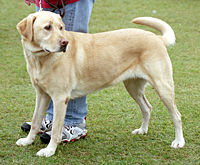 | ||||||||||||||||||
|
Conservation status: Domesticated
| ||||||||||||||||||
| Scientific classification | ||||||||||||||||||
| ||||||||||||||||||
| Canis lupus familiaris |
The dog (Canis lupus familiaris or Canis familiaris) is humankind's first, and perhaps most important, domestic animal. It is usually considered to be a subspecies of the gray wolf (Canis lupus), a mammal of the Canidae family of the order Carnivora.
The word "dog" is also used to refer to some other members of the Canidae family, for instance the bush dog (Speothos venaticus) of South America and the raccoon dog (Nyctereutes procyonoides) of Asia. The family itself is often called the "dog family" and includes jackals and coyotes, which are closely related to dogs and wolves, as well as foxes, which are less closely related. Members of the Canidae family are called "canids."
Characteristics
Dogs, like wolves and other canids, are specialized for a life of hunting and eating other animals. Their bodies are compact and muscular and their legs long, which gives them speed and endurance for chasing prey. Their jaws are large and their teeth are well suited for grasping, biting, and tearing flesh. Their digestive systems are suited for some plant foods as well as flesh.
Most dogs are covered with a thick coat of fur which protects them from the weather. Alaskan Malamutes and Siberian Huskies, which originated in the Arctic, are able to live outside without shelter in temperatures far below degrees Fahrenheit. Dogs' coats come in a wide range of colors, including black, white, brown, yellow, red, and gray (AKC 2006).
Dogs, like other canids, are considered to be among the most intelligent of all animals.
The dog's ancestor, the gray wolf, is the largest canid; with adults weighing between 18 and 80 kg (40 to 175 lbs). Modern dogs can weigh anywhere from 1 to 80 kg (2.2 to 175 lbs). Dingos, wild dogs of Australia which are descended from domestic dogs, average 10 to 20 kg (22 to 44 lbs) in weight (Nowak 1983).
Senses
Sight
In general the vision of dogs is not as good as that of humans. They have only limited color vision, equivalent to red-green color blindness in humans (Alderton 1984). They are also nearsighted compared to humans and can not see detail as well. The average dog's vision seems to be about 20/50 to 20/100, using the human standard. On the other hand they see better in dim light and may also detect motion better than humans (Davis 1998).
Hearing
The hearing of dogs is superior to humans. They can detect sounds which are lower and those which are higher in frequency. They also have a degree of ear mobility that helps them to rapidly pinpoint the exact location of a sound. Eighteen or more muscles can tilt, rotate and raise or lower a dog's ear. Additionally, a dog can identify a sound's location much faster than a human can, as well as hear sounds up to four times the distance that humans are able to. Those with more natural ear shapes, like those of wild canids like the fox, generally hear better than those with the floppier ears of many domesticated species.
Smell
Dogs have nearly 220 million smell-sensitive cells over an area about the size of a pocket handkerchief (compared to 5 million over an area the size of a postage stamp for humans). Some breeds have been selectively bred for excellence in detecting scents, even compared to their canine brethren. What information a dog actually detects when he is scenting is not perfectly understood; although once a matter of debate, it now seems to be well established that dogs can distinguish two different types of scents when trailing, an air scent from some person or thing that has recently passed by, as well as a ground scent that remains detectable for a much longer period. The characteristics and behavior of these two types of scent trail would seem, after some thought, to be quite different, the air scent being intermittent but perhaps less obscured by competing scents, whereas the ground scent would be relatively permanent with respect to careful and repetitive search by the dog, but would seem to be much more contaminated with other scents. In any event, it is established by those who train tracking dogs that it is impossible to teach the dog how to track any better than it does naturally; the object instead is to motivate it properly, and teach it to maintain focus on a single track and ignore any others that might otherwise seem of greater interest to an untrained dog. An intensive search for a scent, for instance searching a ship for contraband, can actually be very fatiguing for a dog, and the dog must be motivated to continue this hard work for a long period of time.
Reproduction
In domestic dogs, sexual maturity (puberty) begins to happen around age 6 to 12 months for both males and females, although this can be delayed until up to two years old for some large breeds. Adolescence for most domestic dogs is around 12 to 15 months, beyond which they are for the most part more adult than puppy. As with other domesticated species, domestication has selectively bred for higher libido and earlier and more frequent breeding cycles in dogs, than in their wild ancestors.
Dogs bear their litters roughly 9 weeks after fertilization, although the length of gestation can vary from 56 to 72 days. A general rule of thumb is that a mammal will produce half as many offspring as the number of teats on the mother. This rule is altered in domesticated animals since larger litters are often favored for economic reasons and in dogs, particularly, the great range of sizes and shapes plays a role in how many healthy puppies a female can carry. An average litter consists of about six puppies, though this number may vary widely based on the breed of dog. Toy dogs generally produce from one to four puppies in each litter, while much larger breeds may average as many as 12 pups in each litter. The number of puppies also varies with the mother's age and health, the father's sperm count, the timing of the breeding, and many other factors.
Lifespan
The typical lifespan of dogs varies considerably by breed. For example, many giant dog breeds (such as Great Danes) average only 7 or 8 years, while some small terrier breeds, or toy breeds might live as long as 20 or above. The average lifespan for mixed-breed and midsize dogs is about 13 to 14 years. The longest-lived dog with reliable documentation died at 29 years and 27 days, the breed of the dog was an Australian Cattle Dog and it lived in Virginia, USA, the date of death was in 1939. The oldest currently living dog is from Canberra, Australia and is now 27 years old. Although the lifespans of all living species are mostly uncontrollable, one can significantly extend a dog's life by feeding it the right kinds of foods, giving it regular exercise, treating its diseases, caring for its special needs and giving it love and comfort.
Social Behavior
Dogs, like almost all canids, are social animals. Wolves, and it is assumed the ancestors of dogs, almost always live in pairs, a male and a female with their young, or in larger groups called packs. Within the pack the individual animals communicate with each other by visual signals such as body and facial expressions and tail wagging and by vocal signals such as growls and howls. The members of the pack cooperate in many activities, such as hunting, caring for the young, and defending their territory from intruders. Within each pack there is a dominant pair which take lead while the others support them. In most cases only the dominant pair reproduce. Studies of feral dogs have found that they often form packs of 3 to 5 individuals (Clutton-Brook 1999, Nowak 1993).
Origins
According to recent genetic research the lineage of dogs separated from that of wolves about 100,000 years ago (Wayne 1997). It is not known when the ancestors of dogs began to associate with humans. The first fossil evidence of domesticated dogs, which have changed in physical form from their wolf ancestors, dates from around 15,000 years ago. Dog fossils from about this time have been found in Asia, Europe, North America, and South America (Clutton-Brock 1999).
Other genetic research seems to indicate that China was the site of the original domestication of dogs (McGourty 2002). Genetic research has identified 14 ancient dog breeds, with the oldest being the Chow Chow, Shar Pei, Akita Inu, Shiba Inu and Basenji. Many of the 14 breeds are associated with China and Japan (Savolainen 2002).
Human relationships
Dogs are highly social animals. This can account for their trainability, playfulness, and ability to fit into human households and social situations. This similarity has earned dogs a unique position in the realm of interspecies relationships.
The loyalty and devotion that dogs demonstrate as part of their natural instincts as pack animals closely mimics the human idea of love and friendship, leading many dog owners to view their pets as full-fledged family members. Conversely, dogs seem to view their human companions as members of their pack, and make few, if any, distinctions between their owners and fellow dogs. Dogs fill a variety of roles in human society and are often trained as working dogs. For dogs that do not have traditional jobs, a wide range of dog sports provide the opportunity to exhibit their natural skills. In many countries, the most common and perhaps most important role of dogs is as companions or pets.
Dogs have lived and worked with humans in so many roles that their loyalty has earned them the unique sobriquet "man's best friend."
Terminology
The English word dog, in common usage, refers to the domestic pet dog, Canis lupus familiaris. The species was originally classified as Canis familiaris by Linnaeus in 1758. In 1993, dogs were reclassified as a subspecies of the gray wolf, Canis lupus, by the Smithsonian Institution and the American Society of Mammalogists.
The English word dog might derive from the Old English "docga", a "powerful breed of canine" like the modern Mastiff. The French dogue and Spanish dogo as in dogo Argentino are borrowings from English. The English word hound is a cognate of German Hund, Dutch hond, common Scandinavian hund, Icelandic hundur which, though referring to a specific breed in English, means "dog" in general in the other Germanic languages. Hound itself derives from the Proto-Indo-European *kwon-, which is the direct root of the Greek κυων (kuōn) and the indirect root of the Latin canis through the variant form *kani-.
In breeding circles, a male canine is referred to as a dog, while a female canine is called a bitch. The father of a litter is called the sire, and the mother of a litter is called the dam. Offspring are generally called pups or puppies until they are about a year old. A group of offspring is a litter. The process of birth is whelping. Many terms are used for dogs that are not purebred.
The constellations Canes Venatici, Canis Major and Canis Minor are named from the Latin word for "dog," for their perceived resemblance to dogs.
Breeds
Different breeds of dogs emerged over time due to environmental factors and human selection. In ancient Egypt dogs looking like the modern Greyhound and the Mastiff are pictured in art. In ancient Roman writings miniature pet dogs like modern toy breeds are mentioned (Clutton-Brook 1999).
As of 2006, the American Kennel Club recognized 153 breeds, divided into 7 groups (AKC 2006):
- Sporting breeds were originally breed and trained to assit gun-wielding hunters in finding recovering birds and other small game. They include pointers, spainiels, and retrievers.
- Hounds were breed to track and engage larger hunted animals. They include the Bloodhound, the English Foxhound, and the Beagle.
- Working breeds were breed for various tasks; such as guarding people, livestock, and property; pulling sleds, and rescuing people from water or snow. They include the Rotweiler, the Saint Bernard, and the Akita.
- Terriers were originally breed to catch and kill small animals, especially rats, without the help of a human hunter.
Working, utility and assistance dogs
There are several types of working dogs:
- Assistance dogs which help the seeing and hearing-impaired. Others are trained to help those with epilepsy and psychiatric disorders, by detecting the onset of the condition so they can seek help. The typical assistance dog is a sociable breed such as a Labrador Retriever.
- The detection dog, which is a dog trained to and works at using its senses (almost always the sense of smell) to detect substances such as explosives or illegal drugs.
- Guard dogs trained to protect property. These are commonly Doberman Pinschers, German Shepherds and Rottweilers or mixes of these breeds.
- Herding dogs trained to protect livestock in the range against predators. Sheepdogs are a common breed.
- Hunting dogs that search for and retrieve game. Pointers and retrievers are typical hunting breeds.
- Police dogs, typically German Shepherds, are trained to assist law enforcement officers.
- Rescue dogs that search for missing humans. The archetypal breeds are the St. Bernard and the Bloodhound, although any dog with a good sense of smell can be trained to perform this task.
- Therapy dogs, with friendly and gentle temperaments, trained to provide comfort and affection to hospitalized and institutionalized patients.
- The war dog, used by the military to detect mines and enemy soldiers.
Show and sport (competition) dogs
Owners of dogs often enter them in competitions, whether show (breed conformation shows) or sports, including dog racing & dog sledding. The winners garner much prestige and prize money. These dogs are often bred specifically for competition, which may not be entirely beneficial for the breeds due to the magnification of hereditary defects.
- Dog agility is a sport in which dogs complete a timed obstacle course.
- Dogsled racing is a winter sport where a team of dogs, usually high performance mixed breed dogs called Alaskan Huskies or Eurohounds, pull a sled and driver (called a musher). The Iditarod Trail Sled Dog Race is perhaps the most famous of these races. Dog sledding is an ancient form of transportation and still a very effective way of moving freight across this type of terrain.
- Dog racing, almost always Greyhounds, involves dogs racing at betting tracks in a sport not unlike horseracing, reaching speeds of 40 miles per hour. Elsewhere, Dachshunds are often raced, as a humorous sidelight in charity events.
- Dog fighting and dog baiting are blood sports involving dogs. They are illegal in most jurisdictions, but are still occasionally performed underground.
- The show dog, purebreds entered in conformation dog shows and evaluated by how closely they match the ideal characteristics of the breed. The Westminster Kennel Club Dog Show is one of the most famous of this type of competition.
Dog health
Dogs are susceptible to various diseases, ailments, and poisons, some of which affect humans in the same way, others of which are unique to dogs. Dogs, like all mammals, are also susceptible to heat exhaustion when dealing with high levels of humidity and/or extreme temperatures.[1]
Diet
At present, there is some debate as to whether domestic dogs should be classified as omnivores or carnivores, by diet. The classification in the Order Carnivora does not necessarily mean that a dog's diet must be restricted to meat; unlike an obligate carnivore, such as the cat family with its shorter small intestine, a dog is dependent on neither meat-specific protein nor a very high level of protein in order to fulfill its basic dietary requirements. Dogs are able to healthily digest a variety of foods including vegetables and grains, and in fact dogs can consume a large proportion of these in their diet. Wild canines not only eat available plants to obtain essential amino acids, but also obtain nutrients from vegetable matter from the stomach and intestinal contents of their herbivorous prey, which they usually consume. Domestic dogs can survive healthily on a reasonable and carefully designed vegetarian diet, particularly if eggs and milk products are included. Some sources suggest that a dog fed on a strict vegetarian diet may develop dilated cardiomyopathy since it lacks L-carnitine,[2] however, maintaining a balanced diet is also a factor since L-carnitine is found naturally in many nuts, seeds, beans, vegetables, fruits and whole grains. In the wild, dogs can survive on a vegetarian diet when animal prey is not available. However it has been noted, both by observation of extremely stressful conditions such as the Iditarod Trail Sled Dog Race and by scientific studies of similar conditions, that high-protein (approximately 40%) diets including meat help prevent damage to muscle tissue. (This research is also true for some other mammals.) This level of protein corresponds to the percentage of protein found in the wild dog's diet when prey is abundant; higher levels of protein seem to confer no added benefit.
Diseases
Infectious diseases commonly associated with dogs include rabies (hydrophobia), canine parvovirus, and canine distemper. Congenital diseases of dogs can include a wide range from hip dysplasia and medial patellar luxation to epilepsy and pulmonic stenosis. Canines can get just about anything a human can get (excluding many infections which are species specific) like hypothyroidism, cancer, dental disease, heart disease, etc.
Two serious medical conditions affecting dogs are pyometra, affecting unspayed females of all types and ages, and bloat, which affects the larger breeds or deep chested dogs. Both of these are acute conditions, and can kill rapidly; owners of dogs which may be at risk should learn about such conditions as part of good animal care.
Parasites
Common external parasites are various species of fleas, ticks, and mites. Internal parasites include hookworms, tapeworms, roundworms, and heartworms. See also CVBD (Canine Vector-Borne Diseases).
Common physical disorders
Some breeds of dogs are also prone to certain genetic ailments, such as hip dysplasia, luxating patellas, cleft palate, blindness, or deafness. Dogs are also susceptible to the same ailments that humans are, including diabetes, epilepsy, cancer, and arthritis. Gastric torsion and bloat is a dangerous problem in some large-chested breeds.
In religion
Islam
- See also Islam and animals
Muhammad, the prophet of Islam expressed that the company of dogs voids a portion of a Muslim’s good deeds.[3]
Islamic law considers dogs to be unclean but this is not derived from the Qur'an.[4] Muhammad is said to have given an order to kill all the dogs in Medina because the angel Gabriel does not enter a house in which there is a dog. This hadith is however the "occasion for revelation" of verse [Quran 5:4] which indicates the importance of the hunting dog.[4] David Gordon White states that Islam, like Judaism and Christianity, usually cast the dog in a negative light by emphasizing its impurity and often identify dogs as demons or minions of the Devil. The story of the Seven sleepers of Ephesus in the Qur'an (and also role of the dog in early Christianity) are the striking exceptions.[5]. Muhammad didn't like dogs (and most Muslims do not have dogs as pets). According to one tradition attributed to Muhammad, black dogs are evil, or even devils, in animal form.[6]
Muhammad commanded Muslims not trade or deal in dogs.[7]
Muhammad said that dogs and donkeys - if they pass in front of men in prayer - they will void or nullify that prayer.[8]
Dr. Khaled Abou El Fadl, a professor of law at the UCLA School of Law where he teaches Islamic law, has written on the subject.[9][10]
?
The English poet Byron (1788-1824) wrote of his Newfoundland, Boatswain (Byron 1808):
- "...Beauty without Vanity,
- Strength without Insolence,
- Courage without Ferocity,
- and all the Virtues of Man,
- without his Vices."
ReferencesISBN links support NWE through referral fees
- Alderton, D. 1984. The Dog. London: Chartwell Books. ISBN 0-89009-786-0.
- American Kennel Club (AKC). 2006. The Complete Dog Book. New York: Ballantine Books. ISBN 0345476263.
- American Veterinary Medical Association (AVMA). 2007. "Market Research Statistics: Cat and Dog Ownership". Accessed July 16, 2007.
- Byron, G. G. 1808. "Epitaph to a Dog" Poetry Lovers Page. Accessed August 2, 2007.
- Clutton-Brook, J. 1999. A Natural History of Domesticated Mammals. Cambridge, UK: Cambridge University Press. ISBN 0521634954
- Davis, J. 1998. [http://www.uwsp.edu/psych/dog/LA/davis2.htm "Color and Acuity Differences
between Dogs and Humans"]. University of Wisconsin, Stevens Point. Accessed August 2, 2007.
- Kruuk, H. 2002. Hunter and Hunted: Relationships between carnivores and people. Cambridge, UK: Cambridge University Press. ISBN 0521814103
- McGourty, C. 2002. "Origin of dogs traced". BBC News. Accessed July 23, 2007
- Nowak, R. M., and Paradiso, J. L. 1983. Walker's Mammals of the World. Baltimore, Maryland: The Johns Hopkins University Press. ISBN 0801825253.
- Savolainen, P., Zhang, Y., et al. {http://adsabs.harvard.edu/abs/2002Sci...298.1610S Genetic Evidence for an East Asian Origin of Domestic Dogs]. Science. Accessed July 24, 2007.
- Voelker, W. 1986. The Natural History of Living Mammals. Medford, New Jersey: Plexus Publishing. ISBN 0937548081.
- Wayne, R.K., Vila, C., et al. 1997. "Multiple and ancient origins of the domestic dog". Science. June 13, 1997. Accessed July 24, 2007.
- ↑ Gedon, Trisha (2006-05-25). Summer heat can be tough on pets. Division of Agricultural Sciences and Natural Resources. Oklahoma State University. Retrieved 2006-08-21.
- ↑ Small animal internal medicine, RW Nelson, Couto page 107
- ↑ Malik Ibn Anas, al-Muwatta’ (Egypt: al-Babi al-Halabi, n.d.), 2:969. Reported in El Fadl
- ↑ 4.0 4.1 Bruce Fudge, Encyclopedia of the Quran, Dog
- ↑ David Gordon White, Encyclopedia of religion, Dog, p.2393
- ↑ Dr. Khaled Abou El Fadl (2004). Dogs in the Islamic Tradition and Nature. Dogs in the Islamic Tradition and Nature, quoting Encyclopedia of Religion and Nature. Retrieved 2007-05-11.
- ↑ Ahmad Ibn Shu‘ayb al-Nisa’i, Sunan al-Nisa’i (Beirut: Dar al-Kitab al-‘Arabi, n.d.), 7: 309 (The commentaries by al-Suyuti and al-Sanadi are in the margins). Ibn Hajar al-‘Asqalani, Fath al-Bari, 4:426. All reported in El Fadl.
- ↑ Al-Nawawi, Sahih Muslim, 3-4:450-1; Ahmad Ibn Hanbal, Musnad, 5:194, 197, 202, 208; Abu Bakr Ibn al-‘Arabi, ‘Aridat al-Ahwadhi bi Sharh Sahih al-Tirmidhi (Beirut: Dar al-Kutub al-‘Ilmiyya, n.d.), 1:133. All reported in El-Fadl.
- ↑ Dr. Khaled Abou El Fadl. Chapter 80 of The Search for Beauty in Islam The Lord of the Essence: A Fatwa on Dogs. www.scholarofthehouse.org. Retrieved 2007-05-14.
- ↑ Dr. Khaled Abou El Fadl. Dogs in the Islamic Tradition and Nature. www.scholarofthehouse.org. Retrieved 2007-05-14.
Credits
New World Encyclopedia writers and editors rewrote and completed the Wikipedia article in accordance with New World Encyclopedia standards. This article abides by terms of the Creative Commons CC-by-sa 3.0 License (CC-by-sa), which may be used and disseminated with proper attribution. Credit is due under the terms of this license that can reference both the New World Encyclopedia contributors and the selfless volunteer contributors of the Wikimedia Foundation. To cite this article click here for a list of acceptable citing formats.The history of earlier contributions by wikipedians is accessible to researchers here:
The history of this article since it was imported to New World Encyclopedia:
Note: Some restrictions may apply to use of individual images which are separately licensed.
